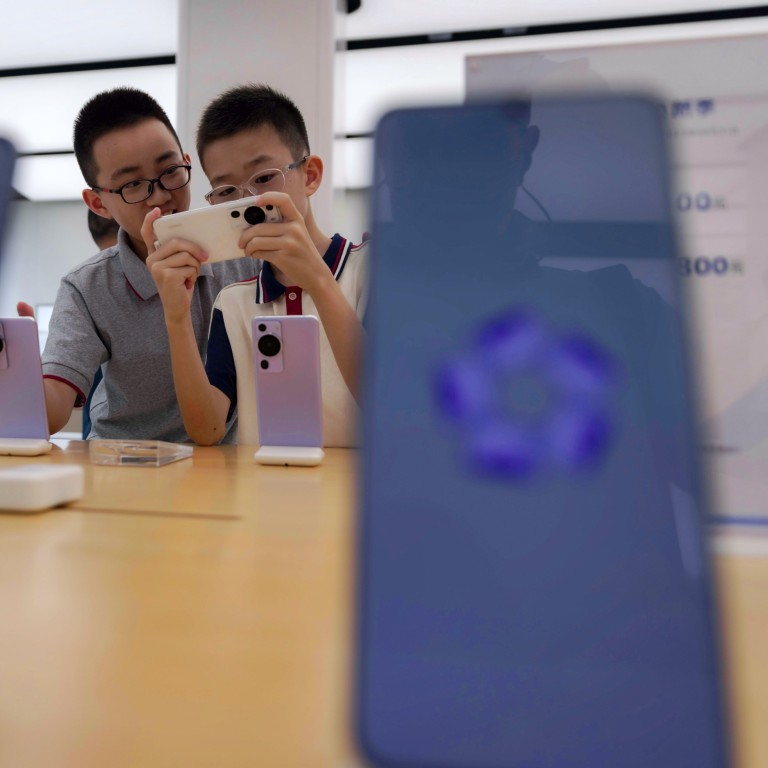
Huawei’s Mate 60 Pro will help it take lost ground in China but can it help the smartphone giant regain global glory?
- Huawei’s Mate 60 Pro may prove popular with domestic consumers but analysts say its overseas appeal will be limited
- Counterpoint says new model could help Huawei make it back into the top four brands in China in fourth quarter but there will be no race to the top
Huawei Technologies is making a comeback in the Chinese smartphone market with its latest Mate 60 Pro handset, but the US-sanctioned company’s chances of taking on Apple and Samsung Electronics again remain slim, analysts say.
In the past week, Chinese consumers have flocked to Huawei’s usually quiet stores to snap up the new model, priced at 6,999 yuan (US$958) and with a home-made processor just a few generations behind the cutting edge, raising hopes that the Chinese giant may be set for a revival.
However, although the Mate 60 Pro from Shenzhen-based Huawei may prove popular with domestic consumers, analysts say its overseas appeal is likely to be limited by the lack of popular apps such as Google Maps. Presales for the phone are only available in China for now, with no information on whether the handset will be sold in overseas markets.
“Huawei’s strong return will have a huge impact on China’s smartphone market in the second half and in 2024, with more impact on other Android-based phone brands vying for the high-end Chinese smartphone market,” said Linda Sui, a senior smartphone analyst with TechInsights.
SMIC under the spotlight for ‘breakthrough’ 5G chip in Huawei’s new smartphone
Sui added that although Huawei may reshuffle the top five smartphone brand rankings in China, it poses less of a threat to California, Cupertino-based Apple because the brands have different target client bases.
Huawei declined to comment on its marketing strategy for the phone.
According to data from consultancy firms IDC and Counterpoint, Chinese smartphone shipments dropped to 286 million units in 2022, with Huawei ranking sixth with a market share of 7.9 per cent, after Vivo, Apple, Oppo, Honor and Xiaomi. This is a big change from Huawei's heyday, when it led the China market for four consecutive years from 2017 to 2020.

After being denied access to advanced semiconductors in September 2020, Huawei – which was once vying with Apple in global markets – saw revenue at its consumer business fall off a cliff in 2021. In 2022, its consumer business dropped a further 11.9 per cent year-on-year to 214.5 billion yuan (US$29.35 billion).
To address the impact of US sanctions, Huawei divested its budget phone operation Honor and the company’s vast national distribution network shrank. It has been out of the top five smartphone brands in China for the past two years.
That is why the Mate 60 Pro model is being seen by some analysts as a potential saviour for Huawei, with sales surging on both online and offline channels.
Ivan Lam, senior analyst at Counterpoint Research, said the new model could help Huawei make it back into the top four brands in China in the fourth quarter, although there will be no race to the top. Shipments of the Mate 60 Series in the first four months after launch could reach 4 million units in the country, according to a Counterpoint research note.
Lam noted that Huawei has lost some of its offline sales channels in the past few years, which has affected its outreach in third- and fourth-tier cities.
TechInsights, the Canadian semiconductor intelligence firm that has identified Semiconductor Manufacturing International Corp as the maker of the Kirin 9000s chip inside the Huawei Mate 60 Pro, has estimated Mate 60 series sales at over 6 million units by the end of the year.
Although the Mate 60 Pro has surprised with its powerful processor in the face of tough US sanctions, questions remain over the stability of Huawei’s supply of chips.
Kuo Ming-chi, an analyst at TF International Securities, noted that Huawei is expected to sell at least 12 million units of the Mate 60 Pro in the 12 months following launch. This will be well up from the 2.5 million sales of last year’s Mate 50 Pro, but still well off likely sales of Apple’s coming iPhone 15 model, estimated at about 90 million this year.
Toby Zhu, an analyst with Canalys, said that the new Mate devices will take sales from Apple and other competitors in the segment. However, Huawei is expected to represent only about 12 to 14 per cent of the estimated 280 million total handsets to be sold in China in 2023, he said.
Additional reporting by Che Pan


